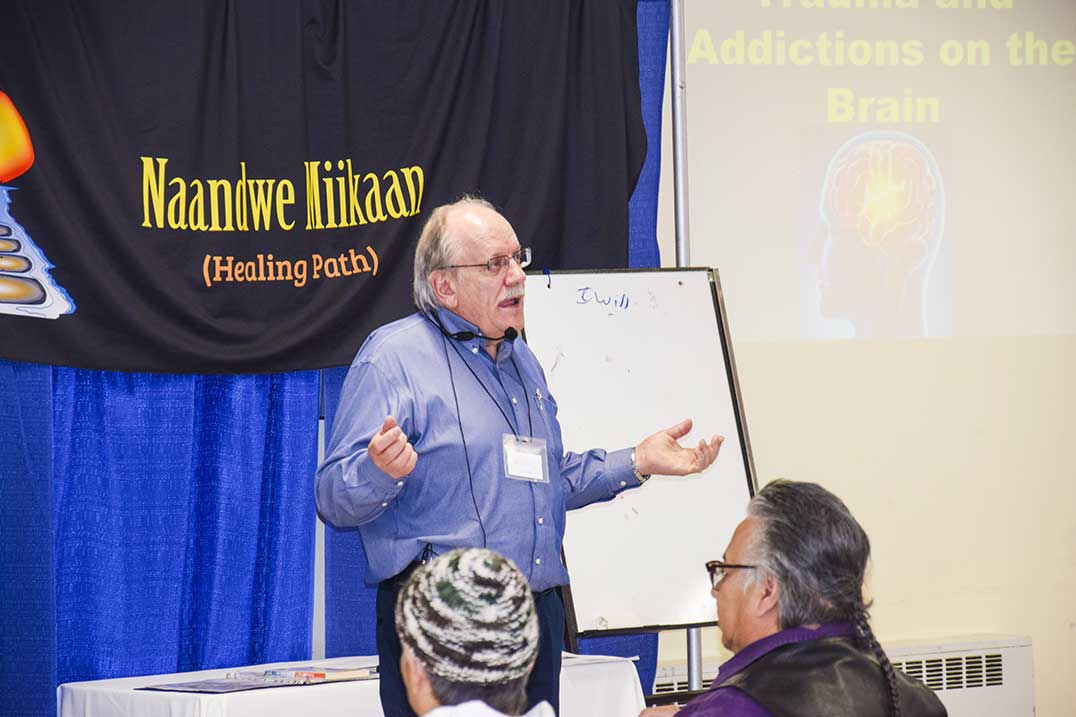WIIKWEMKOONG—A two-day Trauma and Addictions Conference at the Wiikwemkoong arena upstairs hall sought to provide knowledge and wisdom signposts that would assist health workers and community members “to follow the healing path to the good life” (Ka naag doo naa Naandwe Miikaan ji dgoshniyinf mina bimaadziiwin).
At the beginning of the conference Wikwemikong Health Centre’s Mary Jo Wabano and Wiikwemkoong Police Chief Terry McCaffrey signed a protocol agreement between the Mnidoo Mnising First Nations Mental Wellness Crisis Response Team (established under the Wikwemikong Health Centre and Nadmadwin Mental Health Clinic) and the Wikwemikong Tribal Police Service to ensure a culturally appropriate mental wellness response to crisis, setting out policies, procedures and processes with a promise to promote an ongoing working relationship between the two parties.
The conference, put on by the Wikwemikong Health Centre March 6 and 7, was co-facilitated by Emcees Dwayne Animikwan and Kerry Assiniwe and featured a number of local and outsourced professionals in the trauma and addictions field, including Indigenous Program Director Tim Ominika from the Northwood Recovery Treatment Centre, registered psychotherapist Nico Mulder, Emmy Mitchell and Leonard Lazore from Native Connections, Naandwe Miikaan case manager worker Amy Assinewai, community members Dwayne Animikwan and Maigan Fox, as well as sessions on laughter and play by Nadmadwin Mental Health Centre Mental Health Clinic team members Sherri Wabanoose, Cody Wassengeso and Sylvia Recollet.
In addition to the daytime activities and workshops, a mini powwow and community feast was held on the Wednesday evening, complete with a healing jingle dress dance for the community and Ms. Mitchell and Mr. Lazore held an evening loss and grief circle on Thursday.
Mr. Ominika discussed how assisting in one’s wellness is not the job of any one organization, but a collaborative effort of the whole community.
Mr. Mulder’s presentation took his listeners through his life story and personal relationship with trauma and healing. Born on a farm in South Africa with a racist farmer father, Mr. Mulder experienced the loss of his friends (the children of his father’s black farm workers) as the deepening gulf of apartheid policies widened with each passing year of his childhood until they were lost to each other. His father attempted to kill him with his pistol at one point, resulting in post traumatic stress disorder and its host of associated symptoms.
Mr. Mulder challenged the prevailing approach to dealing with trauma (cognitive behavioural therapy or CBT, therapies in which he holds advanced degrees) and put forward a detailed and convincing set of reasons for his position while advocating a more direct and primal approach. CBT, he maintained, while effective in a number of circumstances, simply takes too long and is aimed at the wrong side of the cerebral equation.
“I can see trauma,” he said. “I can sense trauma.” His voice filled with emotion as he recalled his own brushes with traumatic events.

He took his audience on a journey through the human brain, from the central processor or thinking centre of the cortex (which is the general target of the CBT approach), down through the limbic system to the base animal reaction centre of the amygdala, ground zero for all things fear-ish.
The thinking part of the brain, that part that differentiates between the relative personal dangers of the sound of a gunshot you hear in the woods during hunting season and the sound of a gun being fired in the hallway just outside your bedroom, is short-circuited by the impact of trauma; effectively cutting out the sensible balancing impact of the “rationale” brain and putting the raw animal instinct centres in charge of one’s reactions. Put that way, it all makes remarkable sense.
“The issue is not in the cortex,” he maintained, noting that aiming therapy at that part of the brain, while eventually effective, will by definition take a lot longer to bring results. By targeting therapy strategies at the limbic system on the other hand, “sometimes the problem can be dealt with in one session.”
Mr. Mulder enlists the limbic system, that part of the brain that deals with input from the senses, hearing, smell and even tactile, to go directly to those parts of the brain inducing reaction to trauma. He points to oils such as ylang-ylang and sounds that induce a calming effect as key tools.
The psychotherapist notes there are four methods that the brain uses to deal with trauma: fight, run, numb and freeze. These take various forms, fight can include lashing out and harming oneself and/or others; run includes fleeing into video games (“I see dad’s playing video games, I see mom’s playing video games”) just to get away from the problem; numb includes food, drugs and alcohol (“you can try to get rid of your trauma that way, but it doesn’t work”); and freezing will not get you anywhere. “There has to be something more we can do,” he said.
As part of his therapy sessions, Mr. Mulder asks his clients to write a narrative in the third person (using first person retriggers trauma and is counterproductive to the process); by disassociating or distancing themselves from the trauma it becomes less threatening and therefore more approachable.
That narrative begins some time before their birth, nine months before their birth and what happened to their mother, their family environment in which they were formed in the womb. The narrative, usually limited to about six pages, is read back to the therapist at the next session and provides a list of the traumatic things that have happened to the individual. The introduction of bio-lateral music, a steady light snare-like beat-backed combination of white noise and instruments induces brain-spotting and calms the brain down.
Once the brain is calmed, channels are opened to the cortex and a rational assessment of the trauma becomes possible. Sometimes those channels can actually resolve the trauma in one session, but it can also take several sessions, he noted.
One of the most important messages Mr. Mulder brought to the gathering was that, thanks to neuroplasticity of the brain, it can recover. “Your brain can change,” he said. The idea that nothing will ever change is a false prophet that prevents movement along the path of healing and the good life we all desire.
-30-
1,049 words
picks




